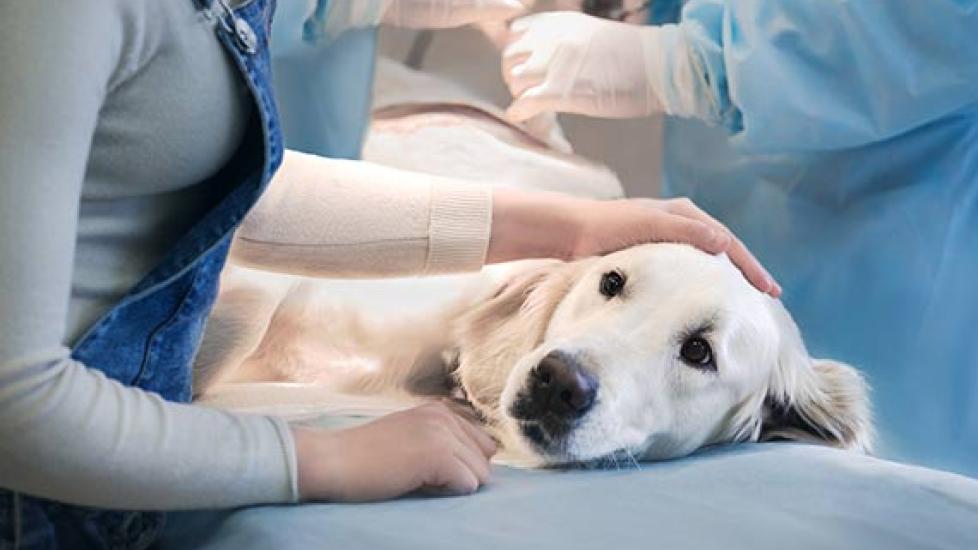What is 'Staging' and Why Is it Important for the Pet Cancer Patient?
When a pet is diagnosed with cancer, the degree to which the body is affected by disease often isn't immediately obvious. While an owner may see a mass-like lesion on a pet’s limb, masses having the same or different cellular makeup can potentially lurk elsewhere in the body.
For descriptive purposes, I use the term mass-like lesion when referring to any tissue swelling. While the mass-like lesion may be composed of a benign or malignant cancer, there also could be single or multiple other disease processes occurring, including:
- Abscess - pocket of white blood cells and bacteria
- Cyst - pocket of fluid, commonly associated with glandular tissue like a sebaceous (oil-containing) cyst
- Urticaria - “hive,” such as that which occurs from a hypersensitivity (“allergic”) reaction caused by an insect bite or sting, vaccination, or other cause
- Foreign body reaction - any foreign material that enters the body, such as a splinter, plant awn (foxtail, etc.), medical implant, or other can create a response where the body attempts to wall off the offending material to protect normal tissues from harm and potentially push the foreign material out of the body.
- Other
When concern for cancer arises, we veterinarians must take a whole-body approach when establishing our patients’ diagnoses and creating a treatment plan. This process is called staging and it has numerous components, which I will cover in this multipart article.
In Cardiff’s cancer diagnosis and treatment process, he’s been put through staging many times and will continue to do so on an ongoing basis in our attempts to keep him in remission for T-Cell Lymphoma.
Here are some of the techniques used when staging a pet for cancer.
Fine Needle Aspirate for Cytology
When the initial suspicion for cancer occurs based on an owner or veterinarian’s discovery of a mass like-lesion, one of the most-common first steps is to get a sample of the tissue via a process called fine needle aspiration (FNA) for cytology (microscopic evaluation of cells).
Performing an FNA is usually minimally invasive and often doesn’t require preparations beyond aseptic technique (cleansing the site, new needle/syringe, etc.) and possibly some degree of pain relief (local anesthesia) or sedation.
FNA involves inserting a needle into a mass-like lesion and pulling back on a syringe’s plunger to create suction that aspirates (sucks out) a small volume of cells that are then placed on a glass slide for cytology.
Although many veterinarians are able to perform cytology on an in-house basis, backing up the initial cytology findings with an official interpretation by a board-certified veterinary pathologist at a diagnostic laboratory (Idexx, Antech, etc.) or university, whose job is to make crucial diagnoses based on cellular changes that may be very subtle or quite obvious, is my recommendation. After all, the diagnosis may be life-changing for both the pet and its owner and having confidence that the correct interpretation has been achieved will ensure that the appropriate steps in performing further diagnostics and prescribing treatment will be undertaken.
FNA and cytology typically provide information that generates important initial conclusions about the nature of a pet’s particular ailment.
Sometimes, enough of a diagnosis can be achieved via FNA and cytology. Other times the results are more vague and indicate that further testing like biopsy is needed to achieve a diagnosis of greater certainty.
Biopsy
Although the concept of collecting tissue for microscopic evaluation is similar, the differences between performing biopsy and FNA are substantial. While FNA is minimally invasive, biopsy is more invasive as it requires a greater degree of pain relief and immobilization, like injectable or inhalant anesthesia.
FNA involves a needle and syringe to aspirate cells, whereas biopsy requires the use of a surgical instrument, such as a scalpel blade or a biopsy instrument (needle, core instrument, etc.) to cut into the mass-like lesion. FNA only permits sampling of a small representative population of cells, while biopsy involves the collection of a section of tissue. Essentially, biopsy is like taking a large scoop of ice cream, while FNA is more akin to a small spoonful.
One of the key places where biopsy and FNA differ is the potential to achieve an accurate diagnosis. Biopsy permits the pathologist to see different layers of tissue. Contained in these layers is information about the presence of both normal and abnormal cells.
Visualizing how the normal and abnormal tissues appear in opposition to each other helps create an increased likelihood that the true nature of the current disease process will be best understood.
Either a piece of tissue or an entire mass is removed when performing a biopsy.
Incisional or core biopsy is where a section of tissue is attained by cutting into the mass.
Excisional biopsy is a procedure where the entire mass is removed from the body.
Some types of cancer can conceivably be cured, or a patient can at least be put into remission (where no other clinical manifestations of disease can be determined), through excisional biopsy.
For Cardiff, excisional biopsy has been the means of resolving his clinical signs and putting him into remission (see Surgical Treatment of Canine T-Cell Lymphoma in a Dog).
I’m an advocate of surgery as the best type of treatment for Cardiff’s cancer, yet it’s not possible, appropriate, or affordable for all pets to have mass-like lesions removed.
In Cardiff’s case he is also receiving ongoing chemotherapy to kill the cancer cells that can form new tumors (see After Cancer Remission, Using Chemotherapy to Prevent Recurrence).
Look for my next articles soon, where I cover blood and urine testing, radiographs (x-rays), ultrasound, MRI, CT scans, and other means of cancer staging used for our pets.
